Sony made a big bet on God of War, putting a team of 300 people to work for years (and nearly five for the game’s creative director) on the PlayStation 4 exclusive. And it all seemed worth it when the game debuted to accolades in April 2018, and then won Game of the Year at The Game Awards in early December.
Cory Barlog wept tears of joy and relief on camera when he saw the review scores come in (it garnered a rating of 94 out of 100 on review aggregator Metacritic) as the game debuted. That was validation for a lot of work over the years in the re-imagining of what was an aging Sony video game franchise.
I caught up with Barlog recently, after enough time had passed the creative director at Sony Interactive Entertainment Santa Monica Studio could step back and talk about the process of making the game. The creative director was candid about the hard work, the self-doubt, and the restarts that happened on the project.
We talked about a lot of things. But this excerpt focuses on the process of making God of War.
Here’s an edited transcript of our interview. This is one of multiple excerpts we’re publishing. Here are links to excerpts on the ending, the alternate design paths, and Barlog’s advice for developers.
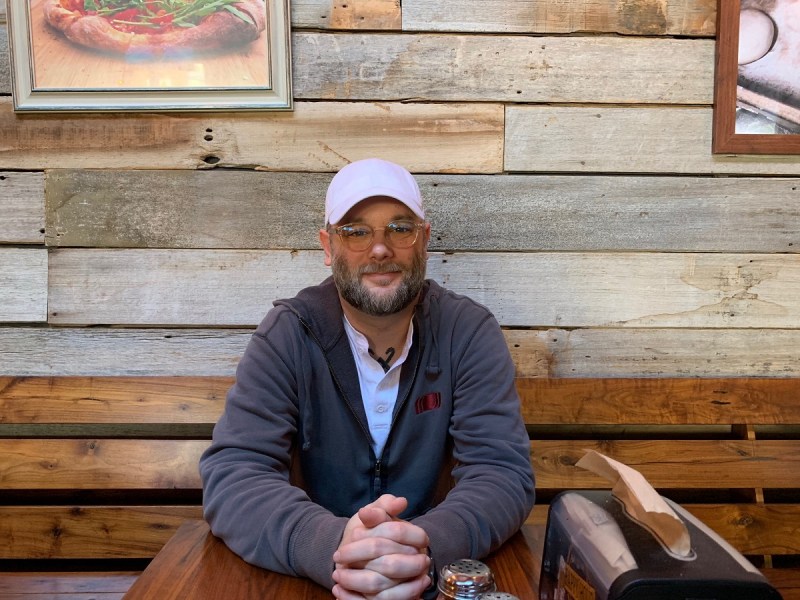
Above: Cory Barlog, creative director at SIE Santa Monica Studio.
GamesBeat: I was a little confused about how much time you had on it. Five years, I’ve heard that in some interviews.
Cory Barlog: Five years is the total time from when I got back. I think it’s just two months shy of five years, when you consider the release date. I came back in June 2013. We released in April of 2018. But I was thinking about the game a little bit before that. I wonder if it was—my son is only six. I don’t know. Maybe I was saying that. But five years was the overall process. Yumi Yang, the producer on the game, likes to say four years, because she doesn’t count that first year. “You were just thinking in that first year. It doesn’t count.”
GamesBeat: I don’t think you ever fully described the circumstances there. You’ve been kind of vague about it. I don’t know if it’s super secret Sony stuff that was going on, but you left, came back, that whole process.
Barlog: That process was—I had done God of War, where I came on for the last two years, and it was a pretty intense last two years. Then immediately I had to jump into writing and directing the second game. I had about a week to a week-and-a-half break in between those two games. Then I finished 2, and I was immediately going into writing and designing the third game after about a week’s break.
I’d been going for years without a break and shipping these games. I was burned out. I wanted, creatively, to get a different experience. I’m not certain how well I knew this or not, but I felt like I didn’t know a lot that I needed to learn, and I wasn’t going to learn it if I was making the same game over and over again.
I think initially I said, “Can I just work with some of these other people while staying at Sony?” Sony said, “No, we don’t do that.” Which makes sense. You’re an employee. So I said, “All right, I need to go do a Caine from Kung Fu and wander the Earth, meet people and learn.” I learned way more during that process than I ever expected. Working with George Miller was an education. It was eight college degrees in character development and directing all at once. And then working with a bunch of other studios. I did a little stint with Lucas. With Crystal Dynamics I did the Tomb Raider stuff. That gave me the perspective I needed. I don’t think I would have been able to make this game had I not had that walkabout.
GamesBeat: That was rebooting as well.
Barlog: Tomb Raider, you mean? Yeah. They’d been working on it long before I got there. I came on to direct the second one, actually, but they brought me in really early and said, “We’re having trouble with cinematics. We need someone to come in and direct the cinematics and finish these things off.” I came on and did that.
That was really good for me, because it gave me a good understanding of, when they were rebooting, what was their process. I ended up using that—this isn’t to say they were wrong. It’s just that the way they approached it, I looked at it and thought, “I’d approach this very differently.” They had a specific goal in mind. But it helped me to see, OK, these are the things you would do if this was the goal. What if that wasn’t the goal? What if the goal was not to reboot, but to reimagine, to continue a timeline? Instead of going back and telling an origin, this is a continuation in the chronology of the story. How would you approach that differently so you don’t just wholly change everything, but figure out how to organically develop it?
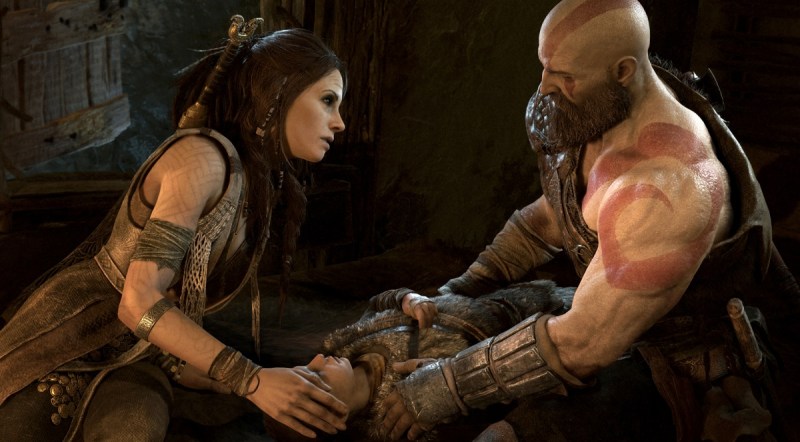
Above: Freya and Kratos with an ailing Atreus in God of War.
GamesBeat: When you were thinking about, I was curious about how soon the father-son concept came into it, or how soon the Norse theme came into it.
Barlog: The father-son came first and then the Norse myths came second. When I first started talking to Shannon, I think in maybe February of 2013, the idea was germinating. I didn’t verbalize it very eloquently. But when I got to the studio in June, I started talking to everybody about, all right—the first idea wasn’t that he was his biological son. We were going to have this kid there and you were never going to understand why he was even there.
As I started digging into the story, I thought, OK, there are a lot of neat ideas in here. Really cool ideas about who Kratos is, who we are—the real cementing of that concept was when I got back to the studio and saw that everybody was old, like me. We all were older. We were so thumb-our-nose-at-authority young when I started in 2003. Now, everybody had kids. Everybody was gray. We were all looking a lot more tired than we were before.
When we talked about things, we talked about them in a different way. We used to be a very combative group. Sometimes the combativeness was just to be combative. Now it was this more measured way of approaching problems. I felt like these developers that I’d come up with—we’d all been apart for years, and we came back together feeling like we’d changed in a very interesting way. It’s not that we were different people. We’d just aged.
I thought that was it. That plus having a son, what that changes, what you go through. This is what it is. Then it was like—people were not that into it. “I don’t get it. Why are we putting a kid in here? That’s weird.” Even Jason McDonald, the lead combat guy, he had said multiple times. “I have a kid. Thinking about going into these scenarios, I don’t want a kid around me. That’s dangerous.” It resonated with him, but in a weird, protective way.
GamesBeat: I don’t want to see my dad rip somebody’s head off either.
Barlog: Right. They all had interesting perspectives on it. But then I recall a meeting that I wasn’t in, where Eric Williams was working with a bunch of people. Everybody was sort of hemming and hawing a bit. I won’t say they were complaining, because it wasn’t negative. They were just expressing their concern. Why is Cory so stuck on this kid thing? And Eric turns around and says, “We’re putting a kid in the game. That’s what Cory wants. Move on. Let’s come up with some ideas.”
It was literally at that moment that everyone just shifted. Let’s figure out how to make this work. That, to me—I didn’t hear about it until after the fact. I was feeling like—wow, I don’t know what I did, but people have suddenly shifted their perspective. It was all because of somebody else. “Focus on getting to solutions instead of complaining about what you don’t like.”
GamesBeat: There was this basic sensible thing about it where—I was not a big fan of first three God of Wars. I was not a God of War person. But I could get into a father-son story. That’s more universally appealing. It lets you do that reboot and get that fresh start with a lot of people. Was that an argument for it? What made you stick to it?
Barlog: There’s a couple of things. There was this sense that—I was telling people that we’d never really had a character—or maybe we have and I’m wrong. Somebody on the internet will call me out on this. But we’ve never really had a character that you grew with. You play this character, and then 20 years later in your own life, you play this character again and they’re further in their life as well. You’re growing on a consistent arc with them. They’re changing. For me, I thought that was really interesting.
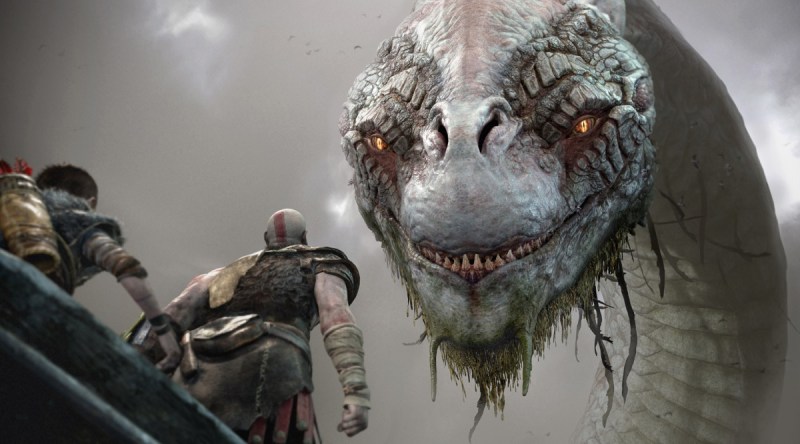
Above: Here’s my sage advice for you.
GamesBeat: Peter Molyneux promised us that at one point, but–
Barlog: Right. Ironically, everybody kept warning me, “Don’t promise people all of these things you’re saying you’re going to do. That never turns out right.” What are you talking about? We’re totally going to do this. We’re going to make it happen. I suddenly realized, that’s the same situation that he was in. He desires these things, these great things, but sometimes those things aren’t possible. I had similar conversations with my team. “Don’t talk about this,” because they didn’t think they could do it, and I still talked about it. But thankfully I work with a pretty brilliant team. The craziest things are made to happen.
Also, the sense that—I think I said, “God of War needs a fresh start, but the player needs a fresh start as well. But we don’t want to just erase the past.” That was an important thing. When I was say those things, people would say, “Let’s just start over. Let’s reboot it.” But I didn’t think we needed to do that. As a writer, you understand how hard it is to build up backstory for characters, so you can have impactful moments. You have to build toward something and then pay it off. We built for 10 years! Let’s not throw that out. Let’s keep that, but let’s take chapter two. Let’s use that and have that resonate even stronger.
How about we make our audience grow a little bit, too? How about we open it up a bit and not just lead with, “Yeah, violence!” I don’t want to say that was a pillar, because it wasn’t really a pillar. It was a reality of warfare. Spartan warfare and what the times of the Greeks and the Romans—this was a very violent time period. It’s not like that was the only thing the game could be about. It was just a reality. But I thought, “Well, it hits harder and means something more if that’s not what you lead with.” You have an emotional investment in it, so that when those things happen, it means something. That’s why, in movies, it means more when you do it right. It’s why Last of Us is so good.

Above: Oh no. Up ahead. It’s a bunch of gamers.
GamesBeat: You had this design freedom. I’m curious about what that actually meant. When you talked to your bosses, what were those conversations like? How did you get the license to just do what you thought was best?
Barlog: Some of it deals with the fact that I worked on the franchise before. But I think that’s a small part. The reason that happens is, people like Shannon Studstill and Yumi Yang. Basically, the two partners I had through this entire project. They’re the shields and they’re the swords. They protect and then they fight back the hordes.
Shannon is there all the time letting everybody know—even if you’re not seeing anything, good things are happening. Have faith. She’s a staunch defender of the creative process. She knows that the creative process doesn’t always bear fruit for a while. It’s easy to get nervous. “Nothing’s being shown. Are you guys messing this up?” At times we show them stuff and that’s what they think. “You’re messing this up. This is terrible.” But it’s the sense of having that partnership where—you always have somebody who has your back.
In the beginning, the very beginning, there were a few discussions with certain groups within the company that had said, “I don’t think you should keep Kratos.” Certain people were saying that keeping Kratos was a good idea. I was being very closed about how much information I was handing out, but they all assumed that if I kept Kratos, we’d just make another God of War. At the high level I was saying, “We’re not going to do that. I’m not telling you what it is yet, but here’s the little bits of information.”
They said, “We think it’s a bad idea to keep Kratos. I don’t understand.” One person even said, “Is he going to put a backpack on and walk up to Scandinavia?” At the time we were pretty close to making that decision. We were in the final stretches, but we weren’t telling everyone at the company about it. He said that negatively, but it was actually, literally, that’s what we were going to do. I pitched him, the same person who said that, about a month later when everything was finalized, and he said, “I love this.”
It was a good example of that sense of—we don’t know what we want. We think we know we don’t want something. But if you can figure out the right mixture, suddenly it sounds great. That’s a testament to, one, the creative support I have from the partners, and two, not telling anybody anything until I figured it all out. When you pitch a half-baked idea it’s so easy for someone to pick it apart and hate on it.
GamesBeat: Did you bounce it off of anyone like Shannon? Or did you go to Shannon saying, “Here’s why you should trust me because I’m going to figure it out”?
Barlog: Shannon, I’ve worked with her since 2003. Her and Yumi, I have an inherent trust with them. But she’ll say, “Barlog, you have to get it together. I need a pitch. I need to know what’s going on.” There was a moment, when I had realized that we were writing the wrong game in our first draft—the focus went away from the father-son story and went far more into the plotting and all the other stuff. That was seven or eight months and I had to throw it all out. We had an outline and everything and I had to get rid of it. I knew it would make the writers upset.
I went to lunch with Shannon and said, “I know you’ll get upset about this, but I’ve been going down a blind alley. I have to go back out and re-assess. Here’s my high level.” This was before the action and the mother. This was just Kratos and his son on a journey. It had no heart to it. I realized that we were in the middle of a story, but not in a good way. I said, “I don’t have it all figured out yet, but here’s the highest level. It’s Kratos and Atreus trying to go to the highest mountain to spread his dead mother’s ashes.” She said, “All right. Do it.”
It was literally—at any other company you’d have to have proof and schedules and budgets and risk assessments and all that stuff to make that kind of change. It was at lunch where I gave her one sentence and she said, “You’re right. That’s better.” Before, she wasn’t saying what I was doing was wrong, because I don’t think either of us had figured it out yet. But once I’d gotten to that one sentence, there it is. That’s it. That’s the thing. I kept telling everyone, “This is what we’re doing. This is the goal.”
Then that became the battle of, well, who’s the big bad guy? After a year and a half, two years, I thought, well, there’s not going to be an antagonist in the same fashion. The antagonist is Kratos. It’s his inability to be open, his inability to actually be a dad. Baldur is a mirror. He’s not even an antagonist. He’s a mirror. His relationship with Freya is this sense of—she held on too tight. She made decisions for him. In doing so, she destroyed the relationship. This is the cautionary tale for Kratos. Do not make decisions for your kid. It’s not going to turn out well. He needs that reminder.
Every single element of the story deals with familial relationships. At all times, every character he interacts with is teaching him a good or a bad lesson, a caution. Don’t go down this road, or you should listen to me about how to be a family, how to be part of a family, and the responsibility. Whether you’re a kid or an adult in that family, you have a responsibility toward the communication and well-being of the family.
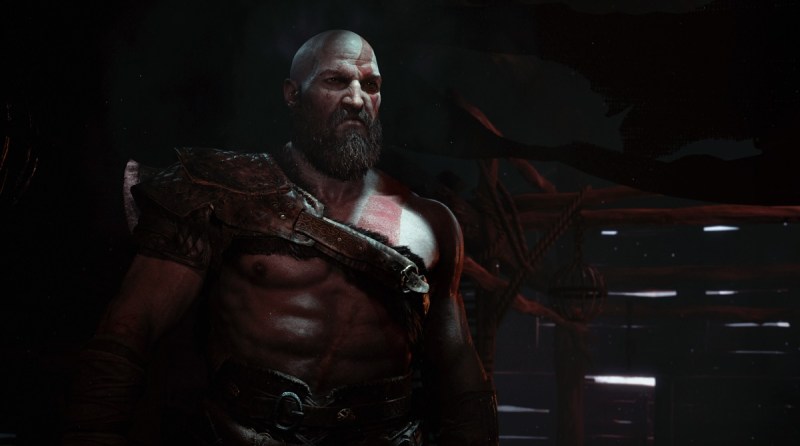
Above: Hey boy, what’s your name?
GamesBeat: You had an open world-ish section of the game. How much of that did you want to have versus telling people where to go to the next part of the story?
Barlog: We kept describing it as “wide linear.” I was adamant that we couldn’t make an open world game. The cost of entry and the expectation level is so high that we’d never compete. We just don’t have the infrastructure and the systems. I don’t want to do that.
GamesBeat: You were 300 people or so?
Barlog: At our peak, yeah.
GamesBeat: Red Dead was more than 3,000.
Barlog: Yeah, I think they were closer to 4,000. At the time I thought the 1,600 that Ubisoft had on Assassin’s Creed was a lot. To do these things, to do the complexity they have, you just need a lot of people. For us, not only do we not want to invest in that aspect of it, but to me the world needed to feel large, and not empty, but with surprising moments of discovery. It could feel like there were areas where there’s not a lot going on, and then all of a sudden an entirely new level opens up that you weren’t directed to, that you just discovered.
Once we started saying wide linear—I didn’t have a term for it. One of the level designers actually started saying that. That was a good way to describe it, because I kept saying, “not open world.” That’s the worst way to describe something, to say what it’s not. It’s better to give a good picture. It was hard for people to understand that, one, I wanted them to do work that might not be seen, which is a really hard thing to convince people about. “You worked hard on this, and 50 percent of players might not see it.” I think that’s okay, because that 50 percent might be told by their friend, “Did you find this?” “No way, you have to go over here to see that?”
That was my experience with Zelda. I talked to other kids at school, and all of a sudden I’d find out that if you put a bomb next to a wall over here you’d find a secret. Those kinds of shared experiences, the sense of feeling like you’re the one discovering these things in the world, that’s very important. But the cost of entry for open world, the gambling systems and territory control—it wasn’t in the cards.
GamesBeat: There’s this need for the usual set pieces. That and the over the top quality. You still wanted these cinematic moments, like the beginning of Uncharted, when he falls out of the plane. You want these big moments, but you don’t necessarily want them to be over the top anymore. I think of Just Cause 4 as completely over the top. You can do any crazy thing there is and put it on YouTube and everybody would laugh.
Barlog: I think the way we described it to the team — to me, this was the breakthrough moment, collectively — what we did before, in a non-pejorative, non-negative way, was like Marvel comics. What we’re doing now is like Marvel film. You can take something like a battle between Captain America and Iron Man and you put it in the film and it’s something my mom would watch. But my mom would not read a Captain America comic book.
We had a similar thing. We started looking at our concept art, at some of the ways we’d done things before. That was the goal. This was Clash of the Titans meets Heavy Metal magazine. It was big and bombastic and over the top. I don’t think that was a bad thing. But it was interesting to see if we could make the MCU transition. Let’s see if we can make the same fun crazy things – they’re fighting on the back of a dragon, hanging off the wings – but we treat it in a slightly different way. The grounding gives it a greater impact.
I think there are still places for games like Bayonetta and Devil My Cry that have this fantastically bombastic feeling to them. But I also think there’s a space to try this idea to transition into something that feels big and over the top, but reserved or reined-in just enough to make it feel like you’re really there.
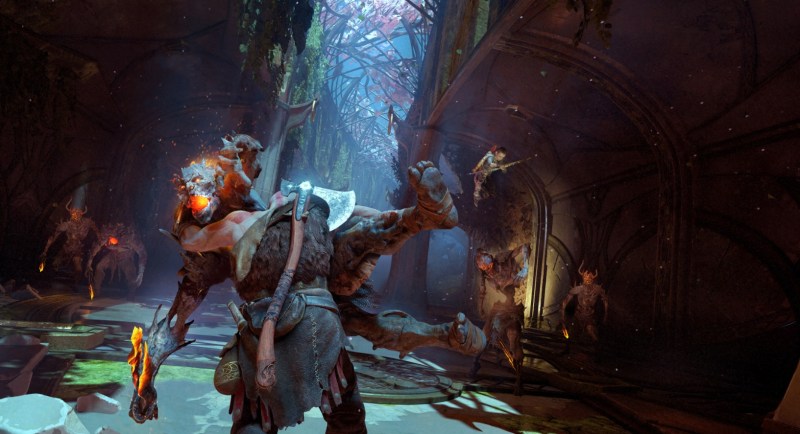
Above: Kratos still gets dirty in God of War.
GamesBeat: I did want to ask why the beginning turned out the way it did. I looked back on a lot of beginnings, and this one was very good. It has a lot of confusion and mystery. You don’t know what’s going on. Why is she dead? You start in the middle of things, like in the ninth year of the Trojan War. It seems at first like the best part of it was at the beginning, but you’re starting almost toward the end. Why did you start in the way you did?
Barlog: That was a very deliberate thing. It took a bit of selling to people. We never do the beginning of the game until the end, but I knew right at the start of the project that I had to start convincing people. We’re not going to start the game with a giant boss battle. Early discussions, I was already laying the groundwork. In the previous games we were all about that first 10 minutes with a big giant creature. It was great, but it was also really hard, by the time we got to God of War 3. You ended up in this arms race. “It’s big, but it’s not as big as that other one.” You’re always comparing it to the previous one and going thumbs up or thumbs down.
We couldn’t do that anymore. We had to throw that arms race out. We had to focus in on what’s interesting. I use the example of Buffy the Vampire Slayer, when they introduced Dawn as Buffy’s sister. They started the episode with the fact that everybody understood and accepted that Dawn was her sister, even though she’d never appeared in the show at all before. They just moved on. I think it was two episodes before they told you that it was a spell and it was all crazy and that’s why everyone was going along with it.
I thought that was really interesting. We’re going to start, and we’re not going to explain everything right away. We’re going to give you really powerful moments that feel important, but you don’t understand why. That way you’ll look back and they’ll have even more weight. But we want you to feel like you’re participating in the tail end of everything, and have this sense of what happened.
The first time I pitched Shuhei Yoshida, the president of Sony’s worldwide studios, on the game, I couldn’t get a minute-and-a-half into my pitch before he said, “Who’s the mother? What’s her name? Where is she from? Is she going to appear in the game? What does she look like?”
GamesBeat: You had your own son. I wonder how much you see your relationship with him in this game.
Barlog: So much. There’s so much of this—the way that Kratos views godhood, as a disease he’s passed on to his kid, is the same concept I look at my kid, with my own psychological idiosyncrasies, my own obsessive-compulsive nature. He’s exhibiting all of that. I gave him that, because my wife is not that way. My wife has anxiety, but she’s nowhere near that—everything has to be done in a certain order, and my kid is that times 1,000, which is so heartbreaking. It’s the same way that–in that moment when Atreus rages out at the end of the game and knocks himself out and nearly dies. It’s seeing that terrible part of yourself in your kid.
Moments throughout the game are pulled from my interactions with him, and my interactions with my dad. Matt and Rich both have kids, so their interactions. So many people on the team, they would tell us stories about interactions with their childrens or their parents. These little stories would find their way in. That’s really interesting. The test for us was—all three of us sitting around, we’d say, “Somebody told me this story today.” And if all three of us said, “Oh, I can relate to that,” we’d feel like we could have more people relate to it. It’s something universal.
There were some things we put in and it didn’t work out. People would say, “I don’t get that at all.” All right, we’ll take that out.
GamesBeat: This is an aside, but when Hellblade came out, did you have any thoughts on their take on Norse mythology?
Barlog: I followed Hellblade through their developer diaries from the beginning. One, because I like Ninja Theory. I think they’re a great group of developers. And then two, because they were into Norse myth, and I’m the most paranoid person ever, always worrying that everybody else is going to use the same ideas that we are.
There was a number of times where I’d come out of my office slamming the door and screaming and going, “Who’s talking to Ninja Theory?” Because they’d be doing something exactly the same way we were. It would happen over and over again. The reality is we’re working in the same mythology, so there are certain things you’ll end up coupling up on. But when they said that they were going to do a single camera shot, I was like, “Seriously? They’re going to be release before us doing the single camera shot thing?”
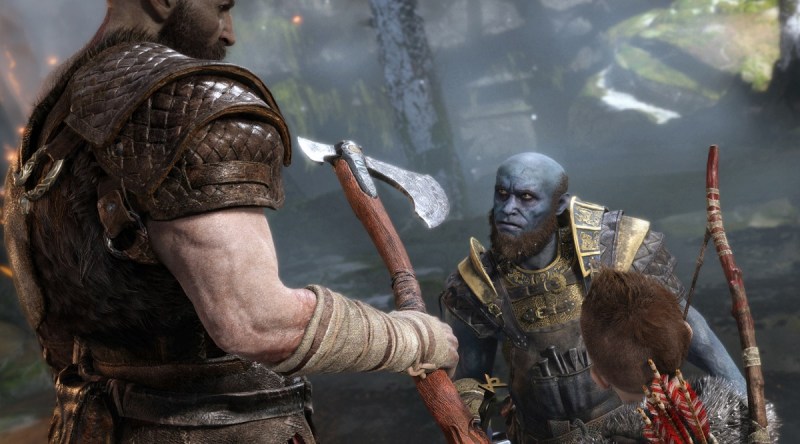
Above: Brok, the blue dwarf, provides comic relief in God of War.
GamesBeat: I didn’t quite grasp the significance of the single camera. Why is it such a big deal? Why was it important to you?
Barlog: I’d worked with a lot of film people. The language of film is cuts. It’s lenses and position and composition and movement, coupled together in a linear format of close-up, medium shot, two-shot, close-up, crane. This is how they speak. We’ve aped that because we love movies, because we’re appreciators of the work that they do. We continue on with that.
But the idea of doing something that embraces video games, which is—the player is in control of the camera, right? Let’s give the player total control, so that when they’re experiencing this, they experience it the way we would experience it in the real world. When I go see the Grand Canyon, I don’t have a crane that accompanies me to give me this awesome distance shot of the Grand Canyon. I stand on the Grand Canyon and look at it. It’s just as amazing. I don’t need this crane shot to make it amazing.
Also, there’s this sense of immediacy that you get from never cutting away, never looking away, and feeling, almost subconsciously, that you have experienced this extremely intimate, personal portrayal. I knew the story needed to be intimate. I wanted no cinematics, no camera cuts. That’s the first thing I said. We’re not doing any cuts and you won’t ever lose control of the camera. You can walk around, and walk away, while people are talking, which freaked people out and rightfully so. We needed to figure out a camera thing before we could do all of that stuff together. So it gave us a bit more freedom to have the camera move in certain motivated instances, but we would never cut away.
Never cutting away means never looking away, to force you to experience these moments, whether they’re uncomfortable or not. You have to be there, and it has to feel personal to Kratos. To me, these were—the difficulty of grasping it is what people experienced the whole time. “I don’t get why this is going to be good.” Whether they would say that you can’t do drama—you can’t have action and drama without camera cuts. You need cuts to give people a break. I said, “No, you don’t. You don’t need that stuff.” You can make it feel like you start the game and you never look away, so it feels like you lived this life with him. You experience these moments as Kratos.
It’s one of these things where—we were making the earlier games, God of War and God of War 2. We had a camera designer who was being interviewed about working on the game. I think he had said, “I work on cameras here. Pretty much, if I do my job right, you have no idea that I do my job.” That was the end result with the camera. You don’t know why, but it feels more personal. That element, you may not be able to piece it together, but that element adds to it. That’s a critical, linchpin element of the personal nature of the game, even if you can’t say why.
It was hard to convince people with just a three-minute snippet of gameplay. When the game was finished I had a bunch of people come into my office and say, “I get it now,” after they finished the whole thing. After just playing an hour of the game or whatever, it didn’t make sense. But when you get all the way to the end—they were playing the 40 hours in two or three days. They were doing a hardcore push. It was more resonant, I think, than when you spread it out over weeks.
For me it was, perhaps, one of those battles that feels like it’s not—there’s no point. Why are you fighting for this? But I had the gut feeling. I just felt this was going to make a huge difference.
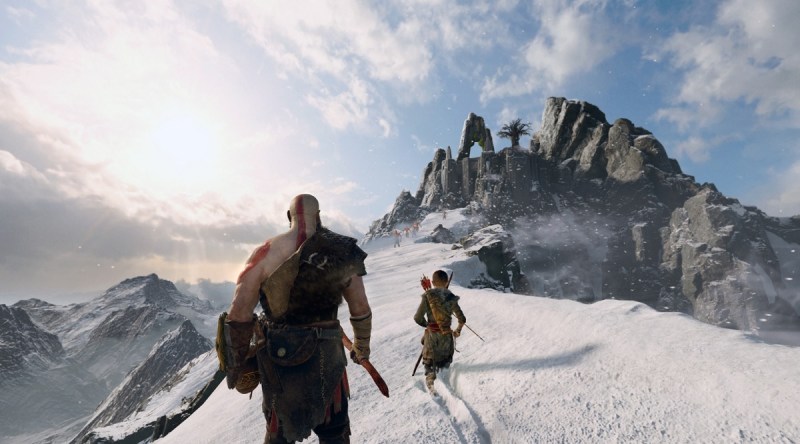
Above: Approaching the mountaintop in God of War.
GamesBeat: It’s been interesting to have this contrast this year with games that were on a fixed timeline, like Call of Duty. You can’t go longer than so many years because you won’t have a Call of Duty one year. Assassin’s Creed tried to stay on that for a while as well, have that one game come out every single year. But then you guys are out of that cycle. You were on a five-year cycle. Red Dead was seven or eight. You had this freedom to go forward and back and forward again. But it’s hard to argue that everything should be this way.
Barlog: The interesting thing, the thing that I think is a stark contrast to film—in film they announce the release date when they sign the deal with the director. You’re doing a Star Wars movie and it’s coming out in two years at Christmas. You know your release data and you have to hit that, all or nothing. Whereas in games, the best games come out when it’s done. I think we should never have parity with movies in that respect. We should always maintain that.
It’s way more complicated. Games that are rushed, that attempt to meet a deadline that’s arbitrarily set early on, everyone suffers from that. The only time that you get the benefit is when someone says, “Hey, we’ll sit on this for a year, so how about you have a small group of people tune it and make it better?” That, I think, is really good. But the bar has just been raised this year, by everyone. It honestly scares me, developing games in the future. How much higher can we raise the bar?
Everybody’s game I play, I’m just like—I have so much work to do. I can feel the fact that everyone is operating on this level that is so far beyond just last year alone. What will games look like in 2020? I don’t even know.

